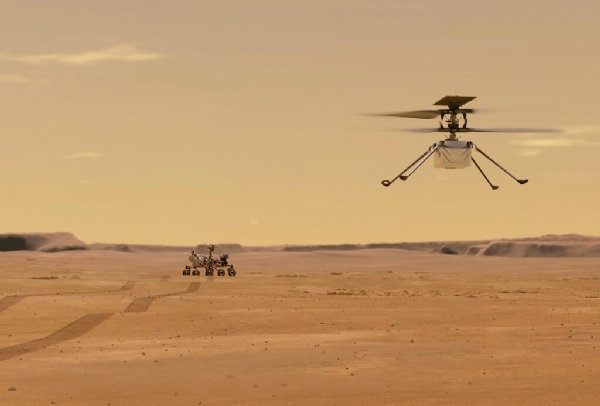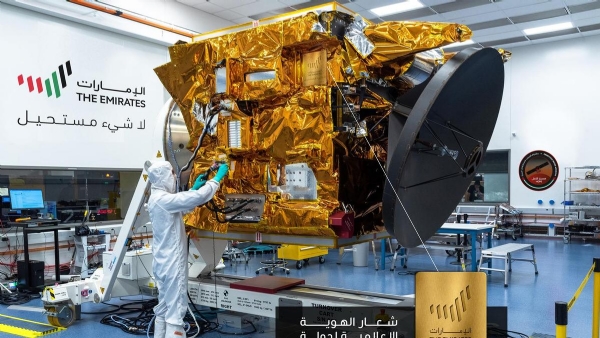INGENUITY of NASA's Mars move! Tapping imperativeness for India’s Moon and Mars Exploration
Total Views |
Early this week, on 19th April 2021, the US space agency NASA achieved a rare feat, a first of its kind. NASA demonstrated a powered flight using a coaxial rotor drone, weighing merely 1.8 kilograms, from the surface of Mars. The INGENUITY, as the drone is called dotingly, was the first-ever powered flight attempted on any other celestial body ever. In the world of orbiter, landers, and rovers, the addition of a drone as a space-probe platform for extraterrestrial exploration is a significant achievement and step ahead.

INGENUITY flew only 3 meters, and even the planned flight tests in the next few days will attempt no more than 6-7 meters of altitude. However, INGENUITY has motivated planetary scientists worldwide to endeavor new space mission designs. Imagine a drone with bigger payload capacity and high-endurance, taking off from Mars, of course vertically, and probing Olympus Mons, the highest mountain in the entire Solar System! Likewise, imagine a drone similarly flying over the ice-filled craters on the South Pole of our Moon! A drone going to Saturn’s moon Titan, which already is planned by NASA, known as DRAGONFLY, will hover over the lakes of ethane and methane on that icy cold Saturnian moon. The possibilities are immense to write down in this article. But again, is it only NASA’s remit? Certainly not. NASA is not a governmental monolith. The lead entity working on INGENUITY is Jet Propulsion Laboratory, a long time NASA partner institution. And where is it based? On the campus of California Institute of Technology, a major private research university.
NASA continues to be the global pioneer in space exploration and the credit goes to the space agency’s ability to interface with for-profit industrial research centers and not-for-profit research centers equally. Many countries have aptly recognized this model set by NASA. Let me give an example here. Six years ago, the United Arab Emirates decided to attempt a Mars mission, HOPE. The HOPE spacecraft needed scientific and technical assistance from the US. It was not NASA that came to the fore, but the University of Colorado. UAE was able to secure launch services from the Japanese space agency, JAXA. Through this international cooperation, the Hope spacecraft was launched, and it successfully reached Mars in early 2021. Although it was UAE’s first space mission, they could have easily called it a technology demonstrator to tame the expectations in terms of new scientific discoveries. While working on HOPE, the UAE government ensured that most space capabilities are not delimited to the space agency and its constituent Mohamed Bin Rashid Space Centre. It made sure that many of its state-led and private universities grow space competencies that complement the space agency and attract global talent. The state-led United Arab Emirates University has set up the National Space Science and Technology Center to cultivate new talent and support the national space goals. The New York University at Abu Dhabi, a private educational institution, has not fallen behind. It, too, is aiming to share the tasks and goals of the state-led university.

What UAE has done is not new. The US has already passed batons of several space missions from NASA to their universities. For instance, the Applied Physics Laboratory at Johns Hopkins University has been at the forefront. The DRAGONFLY mission mentioned above comes from its innovation. The Lunar and Planetary Laboratory at the University of Arizona is among the lead institutions of the ongoing asteroid sample-return mission OSIRIS-REX. China, too has distributed its planetary exploration aspirations to entities like the State Key Laboratory for Planetary Science at the University of Macau. In Europe, Luxembourg has become a vital node of the global asteroid and lunar mining pursuits. The European Space Agency, in late 2020, for the same established its premier European Space Resource Innovation Centre on the campus of the University of Luxembourg. I, too, got an opportunity to work on the ESA Rosetta mission, having graduated from the Max Planck Institute for Solar System Research, a spacecraft engineering and space science institution based out of the University of Göttingen’s campus in Germany.
The recommendation is not to make India follow suit blindly. First, we must realize that the Government of India, with the May 2020 space reforms, has given a free hand to the Indian private sector to participate in the national space exploration goals. This by no means should be assumed as an opportunity only for private companies and startups. Indian universities, especially private universities, must come ahead, set up planetary science laboratories and centers. After all the private participation that the government is hinting at also means ‘not-for-profit’ private entities too. These laboratories and centers will become important ‘missing link’ between the space agency, ISRO, its sister laboratories at the Department of Space and other government ministries, and the private industry.
The US, Europe, Japan, or China do have space agencies and startup and private sector interfaces. But they have equally populated planetary science competencies in public and private universities. Delightfully, Prime Minister Narendra Modi’s administration identified the necessity of an ISRO-Industry arm. It should now explicitly call for an ISRO-Not-for-profit and Not-for-profit-Industry arm in the space sector. Without these two proposed components, India’s progress in space exploration will be skewed.
Indian universities, public and private, need to comprehend the significance of trans-disciplinary planetary science and space science departments and centers. These centers will churn out for the universities’ high-impact research, spawn innovation, churn commercial spin-offs, and train students to spread out in diverse careers. Such centers on university campuses will break the walls between natural scientists, applied scientists and engineers. This will be truly be Advantage India in deep space.
.
.
